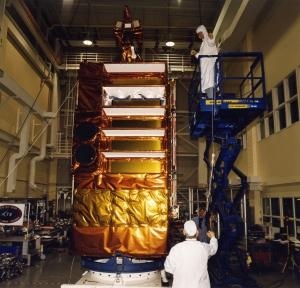Spacecraft Spent Sixteen Years Peering Into The Cosmos' Most
Extreme Environments
After 16 years in space, NASA's Rossi X-ray Timing Explorer
(RXTE) has made its last observation. The satellite provided
unprecedented views into the extreme environments around white
dwarfs, neutron stars and black holes. RXTE sent data from its last
science observation to the ground early on Jan. 4. After performing
engineering tests, controllers at NASA's Goddard Space Flight
Center in Greenbelt, MD, successfully decommissioned the satellite
on Jan. 5.

RXTE far exceeded its original science goals and leaves
astronomers with a scientific bounty for years to come. Data from
the mission have resulted in more than 2,200 papers in refereed
journals, 92 doctoral theses, and more than 1,000 rapid
notifications alerting astronomers around the globe to new
astronomical activity. "The spacecraft and its instruments had been
showing their age, and in the end RXTE had accomplished everything
we put it up there to do, and much more," said Tod Strohmayer, RXTE
project scientist at Goddard.
The decision to decommission RXTE followed the recommendations
of a 2010 review board tasked to evaluate and rank each of NASA's
operating astrophysics missions. "After two days we listened to
verify that none of the systems we turned off had autonomously
re-activated, and we've heard nothing," said Deborah Knapp, RXTE
mission director at Goddard. The 7,000-pound satellite is expected
to re-enter the atmosphere between 2014 and 2023, depending in
large part on solar activity.
RXTE opened a new window into the workings of neutron stars and
black holes. Using its data, astronomers established the existence
of highly magnetized neutron stars (known as magnetars) and
discovered the first accreting millisecond pulsars, a previously
unseen stage in the formation of "recycled" millisecond radio
pulsars that were first glimpsed in the early 1980s. The
observatory also provided the first observational evidence of
"frame-dragging" in the vicinity of a black hole, an effect
predicted by Einstein's general theory of relativity.

RXTE carried three instruments, the Proportional Counter Array
(PCA) and the High Energy X-ray Timing Experiment (HEXTE), which
could be directed to specific targets. The PCA was developed by
Goddard to cover the lower part of the energy range. HEXTE was
built by the University of California at San Diego for exploring
the upper energy range. The observatory's instruments measured
variations in X-ray emission on timescales as short as microseconds
and as long as months across a wide energy span, from 2,000 to
250,000 electron volts. For comparison, the energy of a typical
dental X-ray is around 60,000 electron volts. A third instrument,
called the All-Sky Monitor, was developed by the Massachusetts
Institute of Technology (MIT) in Cambridge. It scanned about 80
percent of the sky every orbit, giving astronomers the ability to
monitor the variable and often unpredictable X-ray sky and to
record long-term histories of bright sources.
The astronomical community has recognized the importance of RXTE
research with five major awards. These include four Rossi Prizes
(1999, 2003, 2006 and 2009) from the High Energy Astrophysics
Division of the AAS and the 2004 NWO Spinoza prize, the highest
Dutch science award, from the Netherlands Organization for
Scientific Research. (Photo provided by NASA)
 SpaceX to Launch Inversion RAY Reentry Vehicle in Fall
SpaceX to Launch Inversion RAY Reentry Vehicle in Fall Aero-News: Quote of the Day (04.23.24)
Aero-News: Quote of the Day (04.23.24) Aero-News: Quote of the Day (04.20.24)
Aero-News: Quote of the Day (04.20.24) ANN's Daily Aero-Linx (04.20.24)
ANN's Daily Aero-Linx (04.20.24) Aero-News: Quote of the Day (04.21.24)
Aero-News: Quote of the Day (04.21.24)




